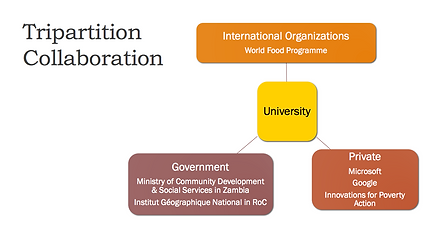top of page
Scalable Multimodal Approaches
Identifying Vulnerable Populations in
The Republic of the Congo

Congo

AdobeStock_267084124_edited

Congo
1/2
This project uses artificial intelligence technologies to more accurately and rapidly identify areas of extreme poverty in the Republic of the Congo, informing humanitarian responses to the country’s surging food insecurity in the wake of COVID-19. The research incorporates daytime satellite imagery, nighttime luminosity, geographic features, and Twitter data to create algorithms that estimate the wealth and livelihood of geographic regions.
..................................................................................................................................................................................
FOOD INSECURITY IN CONGO PRE-COVID
FOOD INSECURITY IN CONGO DURING COVID

FOOD
SECURITY
90%
FOOD
INSECURITY
10%

FOOD
INSECURITY
30%
FOOD
SECURITY
70%
Artificial intelligence (AI) and machine learning (ML) techniques can generate unbiased geographical data and identify areas of extreme poverty, which policymakers can adopt to prioritize development aid allocations. This innovative method can help develop scalable algorithms to inform humanitarian responses to Africa's food crisis. In the Republic of the Congo (RoC), one out of two people live below poverty, and the pre-COVID level of food insecurity of 10% has surged to 30% during the pandemic. Thus far, governments have responded to this crisis by doubling social protection programs. However, the current targeting methods do not provide enough information on eligible communities and are too slow to mitigate transitory shocks. This issue highlights the need for a systemic, fine-grained, and rapid geographic targeting technique.
..................................................................................................................................................................................

Multimodal Approach in Brazzaville, Congo


TWITTER COUNT
NIGHTTIME LIGHTS
While still underway, the project has yielded many rich insights. One main finding is that traditional targeting methods combined with novel data sources better capture households experiencing multidimensional poverty. Specifically, a household’s distance to education services and the average building size on its block are strong predictors of multidimensional poverty, while the distance to health services is a robust indicator of extreme poverty. These types of geographic features that are drawn from Open Street Map, such as building size, are as effective as the opinions of local surveyors and chiefs (village leaders) in determining whether a household is poor. Based on these early findings, the research team is developing machine learning models to improve the accuracy of identifying the most vulnerable households.
..................................................................................................................................................................................
PARTNERS ....................................................
Recipient of Microsoft
AI for Humanitarian Action Project Initiatives
$25,000 Azure Grant
PARTNERS ....................................................

PARTNERS
..........................................................
PARTNERS ....................................................

The research team established an MOU/ data sharing agreement with the Institut Geographique National (IGN) in the Republic of the Congo. The government agency is providing geospatial data on Brazzaville and Pointe-Noire, including administrative boundaries, road network, and waterways.

Image by Annie Spratt

Image by Annie Spratt
1/1
Dr. Jung’s research is expected to have high global impact by offering enhanced data for key development actors to reach people and regions with extreme poverty. This project's outputs, such as high-resolution poverty maps, will be shared with the WFP and the Ministry of Social Affairs to scale up social protection programs. These maps can be updated as new data becomes available to decision-makers in near real time. This work could potentially address misinformation and current criticisms of AI that miss out on the bottom billion, thereby addressing diversity, equity, and inclusion.
RESEARCH TEAM .................................................................
The team consists of computer/data scientists
and social scientists:
-
Woojin Jung (PI) - Rutgers, School of Social Work
-
Dmitris Metaxas - Rutgers, Computer Science
-
Quentin Stoeffler - University of Bordeaux, Economics
-
Saeed Ghadimi - University of Waterloo, AI Institute
-
Dimitrios Ntarlagiannis - Rutgers, Earth and Env. Sciences
-
Arunesh Sinha - Rutgers, Mgmt Science and Information Systems
-
Min Xu - Rutgers, Statistics
-
Tawfiq Ammari - Rutgers, Communication and Information
-
Andrew Kim - Rutgers, School of Social Work
Research Duration
.................................................
July 2021 - Ongoing
The study will conclude with the dissemination of findings to policymakers.
RESEARCH TEAM .................................................................
-
Maryam Hosseini - MIT, Urban Studies and Planning
-
Melissa Sartorius - Rutgers, School of Social Work
-
Sajedeh Goudarzi - Rutgers, Global Urban Studies
-
William Benjamin - Allstate Corp., Data Science
-
Rofaida Benotsmane - Istanbul Technical Univ., Economics
-
Yuxiao Lu - Singapore Management Univ., Computer Science
-
Vatsal Shah - Rutgers, Computer Science, Statistics
-
EJ Knopf - Rutgers, School of Social Work
-
Jamie Cramer - Rutgers, School of Social Work
3 STAGES ..........................................................
-
Assess the current machine learning model
-
Develop new algorithms with a wider application
-
Share this new field-tested and evaluated approach with policymakers
The research team represents diversity across disciplines, countries/continents (Africa, Asia, US), languages, and cultures. Our study can contribute to broadening the reach of social protection programs by identifying vulnerable and poor populations in the Republic of the Congo and other countries where there is very limited, georeferenced wealth data.


This current project in the Republic of the Congo was recently featured in 'Focus on Faculty' on Rutgers University's Office of Research website and social media outlets: .
An impact report is also featured in the Rutgers Global Health Institute's 2021-2022 Annual Report.
bottom of page

